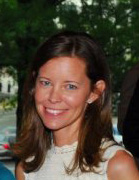 August 2017 Member Spotlight August 2017 Member Spotlight

Name: Jill Haynie
Institution: National Geographic
Position: Director of Donor Stewardship
ADRP member for 1 year
How long have you worked in donor relations/stewardship and how did you get involved in this profession?
I began my Development career as a database administrator and event coordinator. Eventually, I transitioned to volunteer management roles and frontline fundraising positions, but I always knew that stewardship was my favorite part of the job. I liked building relationships with donors and finding meaningful ways to thank them and let them know how their contributions were helping. When a former colleague let me know about a position open at National Geographic focused solely on donor stewardship and communications, I knew I had found my dream job. I feel incredibly lucky to be here at National Geographic doing work I love.
Could you tell us something about the organization you work for?
The National Geographic Society is a nonprofit organization focused on exploring and protecting the planet and empowering people across the globe to help create a healthier, more sustainable world. We give grants to scientists, educators, and storytellers, who are in the field working to find solutions to the challenges we face. We’re fortunate to have the support of our for-profit partners, including our magazine and channels. They’re able to amplify the impact of the work we do by sharing it with millions of people across the globe.
What do you like most about being a member of the ADRP?
I think The Hub is an invaluable resource. I always find at least one article with a perspective I hadn’t considered or a creative solution to an issue I face. I always read it from beginning to end.
What is your greatest donor relations/stewardship achievement?
I love getting to know our donors—where they were born, what’s important to them, what they feel passionate about—and then finding a gift or a way to recognize their support in a deeply personal and meaningful way. We have a rich archive of photographs here at National Geographic and a staff that is passionate about our history and the work we do. I have tremendous resources to draw upon when I’m looking for a way to honor a donor.
What is the most important professional goal you are currently pursuing, i.e., attaining a degree, preparing to give a presentation, launching an initiative at work or in your community, etc.?
I’ve been thinking a lot lately about how to elevate our stewardship and communications efforts. I want to set National Geographic apart from all of the organizations that are in our space competing for support by re-imagining the donor experience. I think donors really want to feel like they’re a part of organizations they support, so I’m looking for ways to provide more access to the people and work they make possible.
How big a role does the use of social media play in your work?
National Geographic has enormously popular social media accounts that highlight our work around the world. They’re a convenient way for our donors to keep up with the people and projects they support. They also provide forums for donors and the public to interact with us.
Is there a resource, i.e., book, blog, website, etc., that you would recommend to other ADRP members?
I love the TED Talk by Simon Sinek called “Start with Why.” It’s a reminder that donor communications are best when they’re less about the organization and more about the challenges we’re trying to solve and how donors can be a part of the solution.
What is the best piece of professional advice you have ever received?
I think it’s important to truly place yourself in the shoes of the donor as often as possible. Whenever I’m deciding on the cadence of our communications, choosing a cover for an annual report, or writing an update on work made possible by donor support, I imagine myself at the dining room table, busy and distracted, opening the mail. If the image I’ve selected or the words I’ve written draw my attention to the work I’m describing, if I feel engaged and I’m moved by what I’m seeing and reading, then I’ve done my job.
Are there any particular stories, insights, etc., from your experiences in donor relations and stewardship that you would like to share with our colleagues?
Early in my career, when I worked for another organization, I was talking with donors at a reception with over a thousand guests, when I learned that a storm overturned the valet table that stored all of the car keys. It was late in the evening and we all grabbed our coats and waited with our donors while the valet staff scrambled to match cars with guests. By the end of the night, we had to send a few guests home without their cars. As you might expect, some guests were incredibly patient and gracious, while others were understandably upset. The next day, we meticulously combed the guest list to determine everyone who attended and sent a sincere letter of apology to every attendee, regardless of whether they suffered as a result of the mishap. We also reached out to those who endured the worst and did something extra special for them. I remember feeling that in the end, it was on balance a positive for the organization, when one person after another expressed surprise that we did so much to address the situation. It’s a reminder that even difficult moments like the valet disaster are opportunities to show donors care and appreciation.

Back to the August 2017 Hub
|